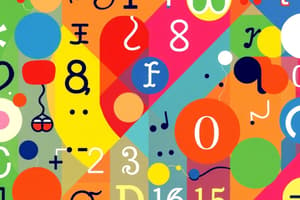Podcast
Questions and Answers
What is the main disadvantage of early programming methods utilized by computers like ENIAC?
What is the main disadvantage of early programming methods utilized by computers like ENIAC?
- They took weeks to create and debug programs. (correct)
- They were limited to mathematical operations.
- They required advanced mathematical skills.
- They used modern programming languages.
Which of the following is NOT a fundamental data type?
Which of the following is NOT a fundamental data type?
- Variables (correct)
- Floats
- Booleans
- Strings
Which of the following correctly corresponds to the purpose of pseudocode?
Which of the following correctly corresponds to the purpose of pseudocode?
- To compile code for execution.
- To write application-specific code.
- To outline programming logic in a simple way. (correct)
- To integrate different programming languages.
What is the hexadecimal notation system commonly referred to as?
What is the hexadecimal notation system commonly referred to as?
Which programming language category processes code at runtime rather than before execution?
Which programming language category processes code at runtime rather than before execution?
In the hexadecimal system, what decimal number does the letter 'E' represent?
In the hexadecimal system, what decimal number does the letter 'E' represent?
What is assembly language primarily used for?
What is assembly language primarily used for?
What data representation format uses a base of 16?
What data representation format uses a base of 16?
What is the function of an assembler?
What is the function of an assembler?
What prefix do some programming languages use to indicate a hexadecimal number?
What prefix do some programming languages use to indicate a hexadecimal number?
Why is assembly language still used today?
Why is assembly language still used today?
How many characters can standard ASCII codes represent?
How many characters can standard ASCII codes represent?
Which programming concept refers to a reusable block of code designed to perform a specific task?
Which programming concept refers to a reusable block of code designed to perform a specific task?
What is the decimal equivalent of the hexadecimal number '10'?
What is the decimal equivalent of the hexadecimal number '10'?
What is a primary characteristic of assembly code?
What is a primary characteristic of assembly code?
What is the primary purpose of flow charts in programming?
What is the primary purpose of flow charts in programming?
Which character encoding standard is known for representing a wider range of characters than ASCII?
Which character encoding standard is known for representing a wider range of characters than ASCII?
Which system is primarily related to binary notation?
Which system is primarily related to binary notation?
What does the 'HEX' option represent in the Programmer view of a calculator?
What does the 'HEX' option represent in the Programmer view of a calculator?
What would the binary representation of the decimal number 42 look like?
What would the binary representation of the decimal number 42 look like?
What does one byte consist of in the binary system?
What does one byte consist of in the binary system?
Which of the following is not a typical use for assembly language?
Which of the following is not a typical use for assembly language?
What does the ASCII system primarily represent?
What does the ASCII system primarily represent?
What might make translating high-level code into assembly easier?
What might make translating high-level code into assembly easier?
What is the binary value for the decimal number 2?
What is the binary value for the decimal number 2?
What happens when you add 1 + 1 in binary?
What happens when you add 1 + 1 in binary?
Which position contributes the highest value in an 8-bit byte?
Which position contributes the highest value in an 8-bit byte?
How many distinct values can one byte represent?
How many distinct values can one byte represent?
What is the binary representation of the decimal number 4?
What is the binary representation of the decimal number 4?
When is it necessary to add a second digit while counting in binary?
When is it necessary to add a second digit while counting in binary?
Which of these binary addition results is INCORRECT?
Which of these binary addition results is INCORRECT?
In which position of a byte does the binary digit represent the value of 16?
In which position of a byte does the binary digit represent the value of 16?
What is one fundamental requirement for computers to operate?
What is one fundamental requirement for computers to operate?
What does the chapter intend to provide an overview of?
What does the chapter intend to provide an overview of?
Why is the number of lines of code a poor measure of program quality?
Why is the number of lines of code a poor measure of program quality?
Which programming language is mentioned as a possible skill for a coder?
Which programming language is mentioned as a possible skill for a coder?
What might indicate the complexity of an application, as mentioned in the chapter?
What might indicate the complexity of an application, as mentioned in the chapter?
In what way do programmers typically organize their expertise?
In what way do programmers typically organize their expertise?
What aspect of programming languages is compared to languages like English and Spanish?
What aspect of programming languages is compared to languages like English and Spanish?
What was true of earlier computer programming compared to the present?
What was true of earlier computer programming compared to the present?
What does the command MOV represent in assembly language?
What does the command MOV represent in assembly language?
What is the purpose of comments in assembly code?
What is the purpose of comments in assembly code?
In assembly code, what does the 'mov' instruction do?
In assembly code, what does the 'mov' instruction do?
Which of the following lines is NOT processed by the assembly language processor?
Which of the following lines is NOT processed by the assembly language processor?
What does the 'section.text' directive indicate in assembly code?
What does the 'section.text' directive indicate in assembly code?
What is the significance of the statement 'int 0x80' in the assembly code example?
What is the significance of the statement 'int 0x80' in the assembly code example?
What is the primary difference between compiled and interpreted languages?
What is the primary difference between compiled and interpreted languages?
Which of the following correctly describes the output of the assembly code provided?
Which of the following correctly describes the output of the assembly code provided?
Flashcards
Binary System
Binary System
A number system that uses only two digits: 0 and 1. Computers use binary to represent data.
Programming Language Categories
Programming Language Categories
Different types of languages like Compiled (C++, Java) or Interpreted (Python, JavaScript).
Data Representation
Data Representation
How numbers, text, and other information are stored in a computer system.
Interpreted Languages
Interpreted Languages
Signup and view all the flashcards
Compiled Programming Language
Compiled Programming Language
Signup and view all the flashcards
Variables
Variables
Signup and view all the flashcards
Pseudocode
Pseudocode
Signup and view all the flashcards
Flowchart
Flowchart
Signup and view all the flashcards
Software Development
Software Development
Signup and view all the flashcards
Programming Languages
Programming Languages
Signup and view all the flashcards
Software Complexity
Software Complexity
Signup and view all the flashcards
Programmer vs Developer vs Coder
Programmer vs Developer vs Coder
Signup and view all the flashcards
Software Diversity
Software Diversity
Signup and view all the flashcards
Computer Instructions
Computer Instructions
Signup and view all the flashcards
Programming Language Grammar
Programming Language Grammar
Signup and view all the flashcards
Programming Specialization
Programming Specialization
Signup and view all the flashcards
Assembly Language
Assembly Language
Signup and view all the flashcards
Machine Code
Machine Code
Signup and view all the flashcards
Assembler
Assembler
Signup and view all the flashcards
Binary System
Binary System
Signup and view all the flashcards
Bit
Bit
Signup and view all the flashcards
Byte
Byte
Signup and view all the flashcards
High-Level Language
High-Level Language
Signup and view all the flashcards
Processor Architecture
Processor Architecture
Signup and view all the flashcards
Binary vs. Decimal
Binary vs. Decimal
Signup and view all the flashcards
Binary Addition (1+1)
Binary Addition (1+1)
Signup and view all the flashcards
Binary to Decimal Conversion
Binary to Decimal Conversion
Signup and view all the flashcards
Bit Position Value
Bit Position Value
Signup and view all the flashcards
Byte Representation
Byte Representation
Signup and view all the flashcards
Binary Value (100)
Binary Value (100)
Signup and view all the flashcards
Binary Example (10010001)
Binary Example (10010001)
Signup and view all the flashcards
Binary vs Decimal Importance
Binary vs Decimal Importance
Signup and view all the flashcards
Hexadecimal System
Hexadecimal System
Signup and view all the flashcards
Base 16
Base 16
Signup and view all the flashcards
Hex Conversion
Hex Conversion
Signup and view all the flashcards
ASCII
ASCII
Signup and view all the flashcards
Programmer View (Calculator)
Programmer View (Calculator)
Signup and view all the flashcards
Decimal System
Decimal System
Signup and view all the flashcards
Numbering Systems (Programming)
Numbering Systems (Programming)
Signup and view all the flashcards
0x Prefix (Hexadecimal)
0x Prefix (Hexadecimal)
Signup and view all the flashcards
Assembly Language
Assembly Language
Signup and view all the flashcards
Mnemonic Code
Mnemonic Code
Signup and view all the flashcards
Comments in Assembly
Comments in Assembly
Signup and view all the flashcards
Hello, world! program
Hello, world! program
Signup and view all the flashcards
Compiled Language
Compiled Language
Signup and view all the flashcards
Processor Instructions
Processor Instructions
Signup and view all the flashcards
Data Directives
Data Directives
Signup and view all the flashcards
High-level Language
High-level Language
Signup and view all the flashcards
Study Notes
Chapter 6: Software Development
- Exam Objectives Covered: 1.1 Compare and contrast notational systems; 1.2 Compare and contrast fundamental data types and their characteristics; 4.1 Compare and contrast programming language categories; 4.2 Given a scenario, use programming organizational techniques and interpret logic
1.1 Notational Systems
- Binary: 0 and 1
- Hexadecimal: 0-9 and A-F
- Decimal: 0-9
- Data Representation: How data is stored and processed
- ASCII: American Standard Code for Information Interchange
- Unicode: Comprehensive character encoding system
1.2 Fundamental Data Types
- Char: Single character
- Strings: Sequence of characters
- Numbers: Integer, float
- Integers: Whole numbers
- Floats: Numbers with decimal points
- Boolean: True or False (represented as 1 or 0)
4.1 Programming Language Categories
- Interpreted: Code is executed line by line
- Scripting Languages: Easily readable, dynamic languages, often used for web pages
- Compiled Languages: Code is turned into machine code (executable)
- Query Languages: Designed for interacting with databases
- Assembly Language: Low-level language directly interacting with the hardware
4.2 Programming Organizational Techniques
- Organizational Techniques: Methods of planning, structuring, and organizing
- Techniques: Flowcharts, pseudocode (used for program design)
- Logic Interpretation: Following instructions and executing tasks.
4.3 Programming Concepts
- Identifiers: Names given to variables, constants, and other program elements
- Variables: Values that can change
- Constants: Values that remain the same
- Containers: Arrays, Vectors (used to store multiple values)
- Functions: Reusable blocks of code
- Objects: Collection of properties and methods (data and processes)
- Properties: Attributes of an object
- Attributes: Characteristics of an object
- Methods: Actions an object can perform
Studying That Suits You
Use AI to generate personalized quizzes and flashcards to suit your learning preferences.




